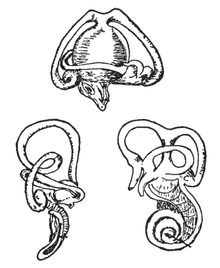The New Student's Reference Work/Ear

Ear, the organ of hearing, especially adapted to receive sound-vibrations from the air. The ear is merely the receiver; it must of course be connected with the brain by the nerve, otherwise there is no hearing. The parts of the ear are thrown into vibration by the sound-waves, and these vibrations are conveyed by the nerves to the brain. If the nerves are destroyed and all the other parts left perfect and uninjured, there, nevertheless, is no hearing. Receiving organs of this kind are placed on the surface in order that they may be in contact with the external world. They are called end-organs or sense-organs. The ear is one, the organs of sight, smell, taste and touch are others. Ears are found very low in the scale of animal life. In the simpler forms they consist of little bags filled with fluid, in which are small, hard particles called ear-sand or ear-stones. The shaking of the bag causes the fluid to vibrate, and the ear-sand is also put in motion, which increases the effect upon the nerves of hearing. In all the vertebrated animals the ear, in common with the other sense-organs, begins on the surface as a patch of the outer cell-layer. There are two round patches on each side of the head, which become sunk in like small saucers (see illustration). The ear starts in this way in all fishes, amphibia, reptiles, birds and mammals. In this stage it is called the ear-saucer or ear-pit. Soon it begins to close by the growth of the skin over it; it becomes a sort of pocket, at first open and then closed, after which it is called the ear-vesicle. From this ear-vesicle, which is little more than a sac, arise gradually all the other parts of the inner ear. In the higher animals three parts are recognized: an outer, a middle and an inner ear. The outer ear includes the part that can be seen and the tube leading inward from the surface. Ear-wax is formed within the tube, and a membrane is stretched across its inner end, called the tympanic membrane. The middle ear is a space filled with air, bounded by the membrane on the outside and the bony wall of the internal ear on the inside. The space is crossed by a chain of three small bones, called the hammer, the anvil and the stirrup. The hammer is fastened to the tympanic membrane, and the stapes to a small oval membrane which covers one of the small openings through the bone into the bony cavity that contains the inner ear. The cavity of the middle ear also communicates with the throat through a passage called the Eustachian tube.

In reptiles and birds there is a single long bone in the middle ear, instead of three bones as in the higher animals. The inner ear is the essential part, in fishes the only part. The middle ear is gradually developed and the external ear added to it as we go up the scale of animal-life above the fishes. The inner ear consists of an upper portion from which three semicircular canals arise, and an inner part which in the higher animals is coiled like a snail-shell and called the cochlea; but this part is fully developed only in mammals (see illustration). The illustration shows the inner ear of a reptile, a bird and an ox. Notice that in the reptile there is no cochlea, only a small projection in place of it; in the bird this projection is longer and curved; and in the ox it has become long and coiled like a snail-shell — the true cochlea. The semicircular canals are present in all three. It is in the cochlea that the most complicated structures are found. The principal branch of the ear-nerve enters here, and becomes connected with certain large cells provided with hairs that vibrate when sound-waves reach them. The whole is inclosed in very hard bone, so that there are a bony part and a membranous part to the internal ear. The membranous part consists of closed sacs full of fluid, and these are also surrounded by a fluid. Thus the arrangement is exactly suited to receive vibrations and transmit them to the ear-nerves. In the cochlea are many little organs, standing side by side on a membrane and forming an arch or tunnel by arching toward each other. These are the organs of Corti. They vary in size, and possibly respond to different sets of sound-vibrations; but, on the other hand, it is possible that they simply act as dampers, somewhat like those in a piano, to prevent the too long vibration of the parts of the membrane upon which they rest. For fuller descriptions of the ear see text-books on anatomy and physiology. See, also, Sound.